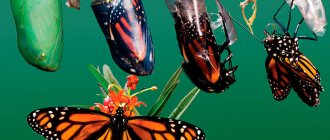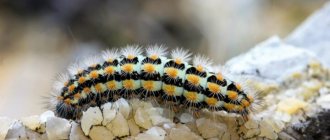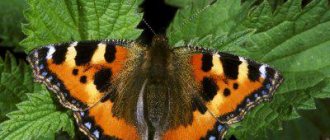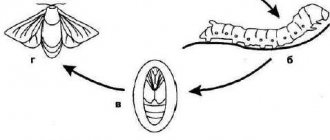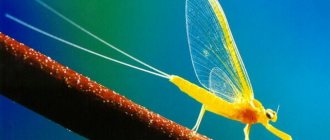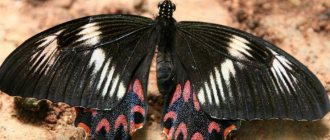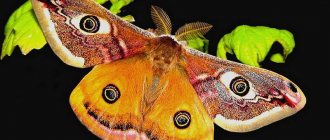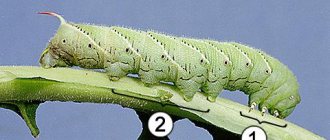Butterfly breeding
The shape and color of the wings are of great importance when breeding butterflies. Some species are sexually dimorphic: males and females differ in appearance, which makes it easier for lepidopterans to find a partner. Other species use pheromones to attract mates. Depending on the species, either males or females can attract a partner in this way. The mating dance is also characteristic of butterflies.
Mating occurs on plant leaves or the ground. It can last from 20 minutes to several hours. By fertilizing a female, the male not only transfers his seed, but also components that are useful during pregnancy. Some species have an interesting feature: after fertilization, a chitinous appendage appears on the female’s abdomen, which eliminates the possibility of repeated mating.
The mating process of the heliconid charitonia is interesting. The female begins to emit pheromones several hours before emerging from the pupa. Males flock to her and begin to fight with each other. The winning male fertilizes the pouch as it emerges from the pupa.
After fertilization, the female lays eggs. This is how butterflies are born. In the tropics, some species can produce up to three generations in one year.
Types of butterfly eggs
Butterfly eggs come in various shapes - round, flattened, oval, spindle-shaped, smooth or with a cellular surface, covered with spines or ribs. The color of the eggs is also different, most often whitish, light green or yellow, in addition, brownish, brownish-violet, reddish. The eggs of many species change color as they develop.
The manner in which eggs are laid may differ among different species of butterflies. Eggs can be laid one at a time or several at a time, or in large groups, up to several hundred in one clutch. Eggs can be laid on leaves, stems, flowers, fruits of plants, in cracks in tree bark, on soil, lichens, and on dry plant remains. After laying, females of some species cover their eggs with hairs from their abdomen.
Caterpillar
In most cases, butterflies lay eggs on specially selected plants. The small caterpillar hatches from the egg and first eats its shell. Afterwards, it begins to feed on the plant on which it is located. If a butterfly lays eggs on the wrong plant, the caterpillar may refuse to eat and look for more suitable food. At this stage of development, the caterpillar stores nutrients that will serve it for the rest of its life.
The caterpillar eats a lot and grows greatly in size in a short time. The skin of a caterpillar is not elastic, so in order to grow, it molts: it sheds its old skin, which has become narrow. To do this, the caterpillar is attached to the plant with a silk thread. The old skin bursts and the larva crawls out. It takes a little time for the new leather to become strong enough. Afterwards the caterpillar begins to eat again.
On average, a caterpillar molts five times before pupating. Before a butterfly emerges from a caterpillar, its body must undergo an astonishing metamorphosis. When the time comes, the insect is attached to a branch or leaf of a plant with a silk thread. She can hold onto the thread with her hind paws or wrap herself around it crosswise.
How a butterfly appears
Where do butterflies come from, such beautiful insects with painted wings. Find out how easy it is for butterflies to be born. Do you know that on average butterflies live 1 month. And during this month they manage to lay several thousand larvae.
Phases of butterfly appearance:
1. An adult female butterfly lays eggs on the leaves of plants. Although she will never see her babies, she still tries to preserve her offspring; for this, some butterflies bury eggs in the ground, while others cover the clutch with secretions from special glands, there are also those that cover the clutch with scales and villi, which they obtain from their own abdomen.
Depending on the type of butterfly and temperature conditions, the offspring develop in the egg from several days to several months.
2. Next comes the second phase: a caterpillar emerges from the egg - this is a butterfly larva. It eats leaves, thereby accumulating energy and nutrients; also during this phase, the caterpillar, the larva, sheds its old skin, this process is called molting.
3. After the last molt, the caterpillars turn into motionless pupae. Having found a safe place, the caterpillar clings to the plant and begins to wrap itself in silk threads, which stick together and form a cocoon. Most often, it has a color similar to the external environment, which allows them to camouflage and preserve their lives. During this period, the cocoon undergoes reconstruction and transformation of the caterpillar into a butterfly. At the end of the transformation period, the cocoon shell bursts and a butterfly emerges from it.
But the butterfly cannot fly right away, since its wings are soft and folded. First it straightens and dries, and only then it flies.
This is the transformation from an ordinary caterpillar to a beautiful soaring butterfly!
How a caterpillar turns into a butterfly is of interest to almost everyone. An equally intriguing question is whether all caterpillars turn into butterflies. There are 156 species in the order Lepidoptera. The history of their appearance goes back to the Jurassic era, they fluttered above the dinosaurs, and the process of their transformation has not changed at all.
Doll
To find out how butterflies are born, it is worth considering the processes that occur inside the pupa. The pupa is motionless and cannot escape from a predator, therefore this is the most defenseless stage in the life of a butterfly. That is why the dolls have such a variety of shapes and colors. They camouflage themselves with foliage and greenery. Some butterflies (such as silkworms) spin protective cocoons that provide additional protection.
With the help of the juice with which the caterpillar digests food, it liquefies its own body. The cells that are formed as a result of this process are called imaginal. They are able to change properties depending on the organ they are to become.
In most cases, the complete transformation from caterpillar to butterfly takes approximately two weeks. There are species in which this process can last for several years. The rate of development of the butterfly in the pupa depends on the external temperature and humidity. Some butterflies pupate before winter to survive the cold.
Egg stage
The first thing in a butterfly is an egg. In butterflies they have a varied shape and a fairly hard shell. They are angular, round, spherical. Their outer surface is embossed with symmetrical tubercles and depressions. The color scheme ranges from white to green, and sometimes there is a colored pattern on the outer surface.
Typically, females can lay more than 1,000 eggs in one clutch. Depending on the species of these insects, they can leave them either in a group of up to 10 pieces, or individually. The egg stage lasts from 8 to 15 days.
Butterfly
How are butterflies born? Cocoon-weaving butterflies can make their way out of the threads to get out. Sometimes they secrete a special liquid that liquefies the silk threads. An ordinary pupa simply cracks and a butterfly emerges from it. Immediately after emerging, the insect's wings are wrinkled and tender. To straighten them, the butterfly looks for a special place. It hangs on a leaf or branch and hangs its wings. Afterwards, the butterfly begins to fill them with lymph, due to which they straighten out. If the butterfly does not have time to quickly get out of the cocoon, or it has nowhere to spread its wings, they will soon dry out, and such an insect will no longer be able to fly.
Usually butterflies emerge from their chrysalis in the early morning when the humidity is high. It may take several hours for the wings to become stronger. Afterwards she is already able to fly. The butterfly takes off and begins searching for a partner to mate with.
Thus, we looked at how butterflies are born. Their life cycle amazes the minds with its complexity and unusualness. After emerging from their pupae, butterflies do not live long. They delight the human eye with their beauty for only a few days, and then they die.
Source
Butterfly mating
So, to understand how a butterfly develops, you need to start with the main stage of the life cycle - mating. Important factors in reproduction are the shape of the wings and their color, as well as courtship options - dancing and mating flights. Males can detect a female more than one kilometer away. Pheromones, as well as odorous scales located on the legs or wings, allow partners to find each other.
Mating of these insects occurs on plants or on the ground for from 20-25 minutes to several hours. All this time the individuals are motionless. By mating, the female gets the opportunity to receive sperm, microelements and proteins from the male. It is the last two components that play a large role in the formation and laying of eggs. In some species of butterflies, after mating, females develop an appendage of chitin on their abdomen, which is formed by the male at the end of the process. It is necessary in order to exclude the possibility of repeated fertilization with another male.
Life cycle of butterflies
The life cycle of butterflies consists of four stages: egg, larva, pupa and adult. Butterflies are insects with the so-called full cycle of transformations, since the larva is completely different from the adult. The transition from one stage to another, or transformation, is called metamorphosis.
Testes are the first phase of insect development. The testicles must be kept safe and sound, so butterflies take care of this, some lay them in the soil, others fill the testicles with gland secretions, which harden in the air - a capsule is obtained, the capsules are usually camouflaged to match the color of the surface.
Another method is that insects cover the testicles with hairs or scales that are scraped from the abdomen. The female lays eggs in batches that can contain several eggs or can reach hundreds of eggs. Depending on the species, they are arranged in layers, in a line or in a ring around the shoot of the plant on which the caterpillars will feed.
In some species, the female disperses the eggs in flight. The development of the embryo depends on climatic conditions and can last from several days to several months, especially when the insect overwinters at the egg stage.
Larvae emerge from the testicles - caterpillars . They actively feed, grow and accumulate substances for the next transformations.
The caterpillar has three pairs of segmented legs armed with claws, and several (up to 5 pairs) false legs equipped with bunches of claws, which allows it to hold well on a support. Caterpillars of daytime butterflies are very diverse in color and external structure. They have a gnawing mouthpart and, for the most part, feed on the leaves of various plants.
Caterpillars grow quickly. Gradually, the outer covers (cuticles) of the larva become too tight for it, and they need to be replaced. Molting occurs, which is preceded by a period of growth. Most larvae have 5 of them, or even more if the larva overwinters. Therefore, the lifespan of a larva can reach from several weeks to several months, and for woodworms up to 2-3 years.
At the last moult, the caterpillar turns into a pupa .
The coloring and body shape of butterfly pupae are no less varied than those of caterpillars. Butterfly pupae do not feed or move; they are usually attached to branches, leaves, various objects (the so-called “belted” and “hanging” pupae), or lie freely on the soil - among fallen leaves and in the soil litter.
The duration of the pupal stage can vary from several weeks (in some tropical species) to nine months or more (in temperate climates with long winters). During this period, organs and tissues change and acquire features characteristic of adults, wings and muscles are formed.
A butterfly emerges from the pupa.
The adult butterfly (imago) quickly reaches sexual maturity and is ready to reproduce within a few days. Depending on how quickly the butterfly fulfills this main purpose, it lives from several days to several weeks. The exception is wintering butterflies, which can live more than 10 months.
Source
Transformation of a caterpillar into a butterfly - the pupa stage
Pupation is the most vulnerable process in the butterfly's development cycle, and most caterpillars prepare carefully for it. The pupal stage in different species can last from several days to several years. A long pause (stop in development) of pupae is an adaptation that allows the species to survive unfavorable years. If in the first year unsuitable conditions arise and the butterflies emerging from the pupae die, the population is replenished by previously diapausing pupae that emerge the next year.
The butterfly formed inside the pupal shell has very short, soft wings. When emerging from the pupa, it needs to climb onto some vertical surface in order to hang its wings, which will give them the opportunity to straighten. After which the wings gradually harden, and during this time the butterfly sits motionless.
The butterfly's body consists of three sections - the head, thorax and abdomen, which contains internal organs.
The head bears antennae, palps, complex compound eyes and mouthparts. The vast majority of butterflies have mouthparts of the sucking type and are a thin long tube-proboscis, which is curled into a spiral when at rest. Many butterflies have underdeveloped mouthparts and are thus unable to feed, subsisting on energy reserves accumulated during the caterpillar stage.
The antennae of butterflies are an organ of smell and come in various shapes - filamentous, club-shaped, feathery, comb-shaped and others. The sense of smell of some butterflies is very developed; males of such species are able to detect the scent of a female at a considerable distance.
The chest of butterflies bears three pairs of jointed legs and two pairs of wings, while the females of some species have underdeveloped wings or are completely wingless, and in some species they are also legless. The pattern on the wings of butterflies is formed by the scales covering them, hence the scientific name of the order - Lepidoptera.
Are caterpillars a separate species of insect?
Caterpillars are not representatives of a separate species, order or suborder of insects. This is one of the stages of development of butterflies - insects belonging to the order Lepidoptera. A caterpillar is a butterfly larva that hatches from an egg and eventually turns into a pupa, from which a beautiful butterfly will actually emerge.
Until the transformation of a caterpillar into a butterfly occurs, the larva has to face many dangers. To survive, caterpillars use various methods of defense. Some scare away with their bright colors, others with an unpleasant odor, and still others are completely poisonous.
Pupa stage
Butterflies have sedentary pupae. The main type characteristic of Lepidoptera is glued. In some families, such as cocoon moths, the pupa lives inside a cocoon that was woven by a caterpillar. The shape is cylindrical, sometimes round. - from light colors to dark ones with the presence of stripes and inclusions. Usually the pupa is located inside glued leaves on the trunks and flowers of plants with the rudiments of the abdomen, wings, legs and proboscis already clearly visible. At this stage of development there is no nutrition.
Stages of butterfly development
Butterflies are insects with a full cycle of transformation, that is, they go through all stages of development:
Each stage of the transformation of a caterpillar into a butterfly takes time and has its own characteristics.
Where do caterpillars come from and how do they grow?
After mating, the butterfly lays eggs. The number of eggs in a clutch depends on what species the insect belongs to. Some butterflies lay up to 1000 eggs. But this does not mean that after a while 1000 larvae will be born. Butterfly eggs have many enemies among insects; in addition, their development is greatly influenced by humidity and air temperature.
Eggs are very diverse in shape. They can be oval, round, pear-shaped, flattened, cylindrical, or cone-shaped. The main color is light green, but there are also white, cream, blue, brown, red, yellow and other shades. Butterflies lay eggs one at a time or in groups of several.
The attitude towards future offspring varies greatly among different species of insects. Some females scatter eggs anywhere, others attach them to a food plant with a sticky secretion so that the emerging larvae do not have to look for food, while others lay them in a secluded place, covering them with their own hairs.
The dense shell of the egg (chorion) protects the developing larva from mechanical stress and drying out. Inside the egg, in addition to the embryo, there is a supply of nutrients that ensure the growth and development of the future caterpillar.
The egg stage in most butterflies takes 1 to 3 weeks, but in some species it can last for months. The larva that emerges from the egg looks like a tiny worm. Its size, depending on the species, can vary from 1 to 5 mm. After the caterpillar emerges from the egg, it goes in search of food.
From caterpillar to chrysalis
As the caterpillar grows, it molts repeatedly. The average number of molts is from 4 to 7, but some species can molt up to 40 times. After each molt, the larva changes, and the changes concern not only size, but also color, and even body structure. In some species the transformations are almost invisible, while in others they are quite pronounced.
After the last molt, the caterpillar turns into a pupa. Shortly before pupation, the larvae stop eating. Many begin to behave restlessly, constantly moving around in search of the most suitable place. Some types of caterpillars look for a secluded place to pupate, others pupate openly. The process can occur on the ground, underground, on a leaf or stem of a plant. The caterpillar larva forms a cocoon by secreting silk threads. Throughout the formation of the cocoon, the larva remains in one place, firmly held by its paws.
It is in the cocoon that the caterpillar transforms into a butterfly.
From chrysalis to butterfly
While in chrysalis form, caterpillars are most vulnerable. They are motionless and cannot protect themselves from predators - birds and insects. The only thing that saves them is that the cocoon usually looks unpretentious and does not stand out much from the background of the environment.
Despite the fact that no movements are noticeable from the outside, many complex processes are taking place inside the cocoon at this time. The transformation from a larva to an adult (imago) in butterflies is called metamorphosis. The final form of the insect is almost completely different from the intermediate one, namely the larva. The only way to recognize the former caterpillar is by its legs.
In the case of butterflies, the caterpillar, once in a cocoon, secretes special substances, under the influence of which its body becomes liquid. In this mass, imaginal discs are preserved, that is, clusters of cells responsible for the formation of new tissues and organs of the future butterfly.
When the metamorphosis is completely completed, the insect secretes enzymes that corrode the shell, after which the butterfly can get out of the cocoon. First the head appears, then the body and legs squeeze through.
Types of butterflies
The color of butterfly wings is varied. In some they are beautifully and brightly colored, while in others, on the contrary, they have a modest protective color, allowing them to be invisible on flowers and herbs, tree bark, stones, and lichens. Many species are characterized by sexual dimorphism, that is, a pronounced external difference between male and female in color, shape and size of wings, as well as in the structure of the antennae. Occasionally there are individual, atypically colored individuals called aberrants.
Gynandromorph butterflies, that is, individuals that combine the characteristics of a male and a female, are extremely rare. Gynandromorphs of species that are characterized by pronounced sexual dimorphism look very unusual. In this case, on one side of the butterfly’s body there are wings with the color of the male, and on the other - with the color of the female.
Most butterflies are active at dusk and at night, with a much smaller number of species active during the day. However, it is the diurnal butterflies that are the most visible, and, as a result, the best studied. Many butterflies are good flyers; some species are characterized by regular migrations, which often leads to their wide distribution. Others, on the contrary, inhabit only small geographical regions; such species are called endemic.
Life cycle of butterflies (metamorphoses): butterfly development
Numerous orders of insects are conventionally divided into two groups. In representatives of the first group, the larvae emerging from the egg are similar to adult individuals and differ from them only in the absence of wings. These include cockroaches, grasshoppers, locusts, bedbugs, praying mantises, stick insects, etc. These are insects with incomplete transformation. In the second group, the eggs hatch into worm-like larvae, completely different from their parents, which then turn into pupae, and only after that do adult winged insects emerge from the pupae. This is the development cycle of insects with complete transformation. These include mosquitoes, bees, wasps, flies, fleas, beetles, caddis flies, and butterflies.
Conversion process
How long it takes for a caterpillar to turn into a butterfly while in a cocoon depends on climatic conditions and the type of insect. From a few days to 14 years. Moths in our area appear on average after 15 days.
What is the name of the process of transformation of a caterpillar - metamorphosis. More precisely, holometamorphosis, since some parts of the larva remain. In this case - paws. Experts understand this term as a complete degeneration of forms. Just as a plastic bottle is melted, a glass is then made.
In a cocoon that appears completely motionless, complex processes take place inside. The body splits and turns into a liquid mass with imaginal discs. To make it clearer, these are similar to stem cells, and any organs or tissues can be formed from them.
Upon completion of the process of transformation from a caterpillar to a butterfly, the formed insect secretes a special secretion, which allows the walls of the cocoon to be split. Initially the head is shown, then the body, legs. The newborn insect sits motionless for several minutes, waiting for its wings to dry. Then he straightens them and begins to search for the opposite sex for mating.
What is metamorphosis and why is it needed?
Metamorphosis, i.e. a life cycle with a series of successive transformations is a very successful acquisition in the struggle for existence. Therefore, it is widespread in nature and is found not only in insects, but also in other living organisms. Metamorphosis allows different stages of the same species to avoid competition among themselves for food and habitat. After all, the larva eats different food and lives in a different place; there is no competition between the larvae and adults. Caterpillars gnaw leaves, adult butterflies calmly feed on flowers - and no one bothers anyone. Through metamorphosis, the same species simultaneously occupies several ecological niches (feeding on both leaves and flowers in the case of butterflies), which also increases the species' chances of survival in a constantly changing environment. After the next change, at least one of the stages will survive, which means the entire species will survive and continue to exist.
Caterpillar care
- Buy a special kit for breeding butterflies at a pet store. This kit has everything you need to raise healthy butterflies. But, you can take a more difficult path and find caterpillars on trees. In this case, you will need to find out a lot about their species, and get food for them every day. When purchasing a set, choose a species of butterfly that can survive in your climate;
- Without purchasing a kit, caterpillars must be kept in a four-liter container with the neck closed with gauze. This method will prevent the caterpillar from escaping from you and will ensure ventilation of the container. The set also includes a container for containing them;
- It is recommended to keep 2-3 caterpillars in a container, otherwise after the butterflies hatch they will not have enough space;
- Containers with caterpillars must be cleaned every day, otherwise dangerous mold may appear in it. To make this work easier for yourself, lay down paper napkins;
- Do not forget to change the leaves every day so that they do not become dry and old. Together with fresh leaves, the caterpillars receive all the moisture they need, so there is no need to place dishes with water in the container.
Butterfly development: four stages of the life cycle
So, butterflies are insects with complete transformation - they have all four stages of the corresponding life cycle: egg, pupa, caterpillar-larva and imago - an adult insect. Let us consider sequentially the stages of transformation in butterflies.
First, the adult butterfly lays an egg and thereby gives rise to a new life. Depending on the type, eggs can be round, oval, cylindrical, conical, flattened and even bottle-shaped. Eggs differ not only in shape, but also in color (usually they are white with a green tint, but other colors are not so rare - brown, red, blue, etc.).
The eggs are covered with a dense hard shell - the chorion. The embryo located under the chorion is equipped with a supply of nutrients, very similar to the well-known egg yolk. It is by this that the two main life forms of lepidopteran eggs are distinguished. Eggs of the first group are poor in yolk. Those species of butterflies that lay such eggs develop inactive and weak caterpillars. Outwardly, they look like tadpoles - a huge head and a thin, thin body. Caterpillars of such species must begin to feed immediately after emerging from the egg, only after which they acquire fully plump proportions. That is why butterflies of these species lay eggs on a food plant - on leaves, stems or branches. Eggs placed on plants are typical for diurnal butterflies, hawk moths, and many cutworms (especially lancets).
Cabbage butterfly eggs
In other butterflies, eggs are rich in yolk and provide the development of strong and active caterpillars. Having left the egg shell, these caterpillars immediately begin to crawl away and are able to cover sometimes quite significant distances for them before finding suitable food. Therefore, butterflies that lay such eggs do not need to worry too much about their placement - they lay them wherever they need to. Thinworms, for example, scatter eggs on the ground in bulk right on the fly. In addition to slender moths, this method is typical for bagworms, glassworts, many moths, cocoon moths and bear moths.
There are also lepidoptera that try to bury their eggs in the ground (some cutworms).
The number of eggs in a clutch also depends on the species and sometimes reaches 1000 or more, however, not all survive to the adult stage - this depends on factors such as temperature and humidity. In addition, butterfly eggs have no enemies from the insect world.
The average duration of the egg stage is 8-15 days, but in some species the eggs overwinter and this stage lasts months.
Caterpillar
A caterpillar is the larva of a butterfly. It is usually worm-shaped and has a gnawing mouthpart. As soon as the caterpillar is born, it begins to feed intensively. Most larvae feed on leaves, flowers and fruits of plants. Some species feed on wax and horny substances. There are also larvae - predators; their diet includes sedentary aphids, scale insects, etc.
During the process of growth, the caterpillar molts several times and changes its outer shell. On average, there are 4-5 molts, but there are also species that molt up to 40 times. After the last moult, the caterpillar turns into a pupa. Caterpillars of butterflies living in colder climates often do not have time to complete their life cycle in one summer and enter a winter diapause.
Many people think that the more beautiful and colorful the caterpillar, the more beautiful the butterfly that develops from it will be. However, it is often just the opposite. For example, the brightly colored caterpillar of the great harpy (Cerura vinula) produces a very modestly colored moth.
Doll
The pupae do not move or feed, they just lie (hang) and wait, using up the reserves accumulated by the caterpillar. Outwardly, it seems that nothing is happening, but this last stage of the amazing transformation can be called a “turbulent calm.” At this time, very important life processes of restructuring the body are boiling inside the pupa, new organs appear and form.
The pupa is completely defenseless; the only thing that allows it to survive is its relative invisibility from its enemies - birds and predatory insects.
Peacock butterfly pupa
Typically, the development of a butterfly in the pupa lasts 2-3 weeks, but in some species the pupa is a stage that enters winter diapause.
Pupae are silent creatures, but there are exceptions: the death's head hawkmoth pupa and the Artaxerxes blueberry pupa can... squeak.
Imago
An adult insect, the imago, emerges from the pupa. The shell of the pupa bursts, and the imago, clinging to the edge of the shell with its feet, while exerting a lot of effort, crawls out.
A newborn butterfly cannot fly yet - its wings are small, as if curled, and wet. The insect necessarily climbs to a vertical elevation, where it remains until it fully spreads its wings. In 2-3 hours, the wings lose their elasticity, harden and acquire their final color. Now you can take your first flight!
The lifespan of an adult varies from several hours to several months, but on average the lifespan of a butterfly is only 2-3 weeks.
Source
Caterpillar stage
The butterfly larva is a worm-like caterpillar. She has a pronounced gnawing mouthparts. The caterpillar has a special secretion that hardens in air and forms a silk thread. The larvae are mainly phytophagous, that is, their food is flowers, leaves and fruits of plants.
There are also types of caterpillars that eat the larvae of ants, aphids and mealybugs. These species are predators. On the body of the caterpillar there are 10 abdominal segments with five pairs of thick legs and 3 thoracic segments with three pairs of jointed legs. The body has smooth skin with spikes, warts and hairs. Caterpillars usually live on the ground, trees, and bushes, but some of them, such as broad-winged moths, can live underwater. They can be divided into two large groups:
- caterpillars prone to a free lifestyle;
- caterpillars prone to a hidden lifestyle.
The latter construct portable cases from silky thread in which they live. They carry it on themselves and hide in it. Also, caterpillars build themselves a cigar-shaped cover from leaves in the form of a shelter, having previously secured it with silk thread. The development cycle of a butterfly at this stage can last several years. Caterpillars in northern latitudes may enter a state of diapause until next summer. For example, the life cycle of the larvae of the seaweed, which lives in Greenland, can last up to 14 years.
Choosing a place for wintering
Many butterflies lay eggs in the summer to produce a new generation and then die. But there are real long-livers. If you need to find out what winter butterflies live in Russia, then you should turn to trusted sources. Wikipedia states that lemongrass, urticaria and burdocks live on the territory of the Russian Federation, which simply sleep in winter. They climb into hollow trees, various crevices and wrap themselves in their wings. Many insects prefer to prepare thoroughly for wintering, which is why they try to find a reliable place closer to human habitation.
To understand where butterflies go in winter, you need to take into account that science knows the migration of lepidopterans, which, huddled in flocks of up to 1 million individuals, fly to warmer climes in the fall. But even numerous experiments by scientists could not explain how exactly these creatures find the right path. The thing is that they have a primitive nervous system, which is why they cannot navigate by the sun.
The caterpillars of some species of bluebirds prefer to live inside large anthills. Worker ants carry insects to their nest. In such conditions, the caterpillars live until they pupate and become an adult butterfly. All this time, the ants not only feed the caterpillar, but also try to do everything possible to protect it from various dangers. This happens for the reason that the insect makes the same sounds as the queen ant.
Main suborders
Primary toothed moths are small butterflies with a wingspan of four to fifteen millimeters. Representatives of the suborder include small-winged golden and marigold
Proboscisless. The size of the wings is no more than twenty-five millimeters.
Proboscis. The suborder is represented by several dozen families. This suborder has a very varied appearance and is very diverse
